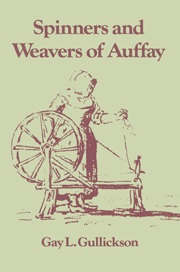 The Spinners and Weavers of Auffay
The Spinners and Weavers of Auffay Book contents
- Frontmatter
- Contents
- Preface
- 1 Introduction
- 2 The pays and the village
- 3 Proto-industrial theory and the pays de Caux
- 4 The golden age of spinning
- 5 Crisis and change in the Caux
- 6 The golden age of cottage weaving
- 7 Marriage and family in proto-industrial Auffay
- 8 Widowhood, remarriage, and the sexual division of labor
- 9 Unwed mothers and their children
- 10 Conclusions: the causes and consequences of proto-industrialization
- Appendix Vital statistics for Auffay
- Notes
- Bibliography
- Index
10 - Conclusions: the causes and consequences of proto-industrialization
Published online by Cambridge University Press: 29 October 2009
- Frontmatter
- Contents
- Preface
- 1 Introduction
- 2 The pays and the village
- 3 Proto-industrial theory and the pays de Caux
- 4 The golden age of spinning
- 5 Crisis and change in the Caux
- 6 The golden age of cottage weaving
- 7 Marriage and family in proto-industrial Auffay
- 8 Widowhood, remarriage, and the sexual division of labor
- 9 Unwed mothers and their children
- 10 Conclusions: the causes and consequences of proto-industrialization
- Appendix Vital statistics for Auffay
- Notes
- Bibliography
- Index
Summary
By 1850, the cottage textile industry, hence, the proto-industrial period in the pays de Caux, was about to collapse. Every slump in the cotton industry drove more hand-loom weavers out of the craft and produced more power-loom operators until finally, in the 1870s, the bottom dropped completely out of the hand-weaving industry, and the rural exodus that had begun in the 1840s became a mass migration. The changes wrought by the spread of the cotton industry paled beside those created by its demise. The Caux bcame more purely agrarian and much more sparsely populated than it had been in at least a century and a half. Farmers found it more and more difficult to hire laborers as virtually everyone who did not own property pulled up stakes and moved to the city. Weaving families who did not move found themselves forced into agricultural day laboring.
Because of its drama, factory building and urbanization have a much more extensive history than does the eighteenth-century expansion of cottage industry. But no study that assumes that the process of industrialization was a purely urban phenomenon paints an accurate picture of the transition from cottage to factory production. The current research on proto-industrialization thus provides an important corrective to what has often been an oversimplified and inaccurate view of the industrialization process.
- Type
- Chapter
- Information
- The Spinners and Weavers of AuffayRural Industry and the Sexual Division of Labor in a French Village, pp. 195 - 204Publisher: Cambridge University PressPrint publication year: 1986
